The recent release of church court records on Scotland's People has widened the breadth of church records now accessible on the site. Within the kirk session volumes are a wealth of newly added categories of records which can add more details to family trees and are also a useful source for church, social and local historians.
Kirk session records provide a vivid snapshot into the lives of ordinary Scots and can give fascinating insights into how they lived, worked and worshipped. They are primarily a record of the disciplinary cases heard and any other decisions taken by the session. However, most kirk session minutes contain much more than this because they also had civil responsibilities and carried out many functions later taken over by local government including school education and poor relief.
In this article we have highlighted some of the different record types found in this latest release of church records.
School records
Details of parish schools can be found within many of the kirk session minutes. These records can include class registers, details of building new schools, parochial schoolboard minutes, appointment of schoolmasters and Sunday (or Sabbath) school rolls.
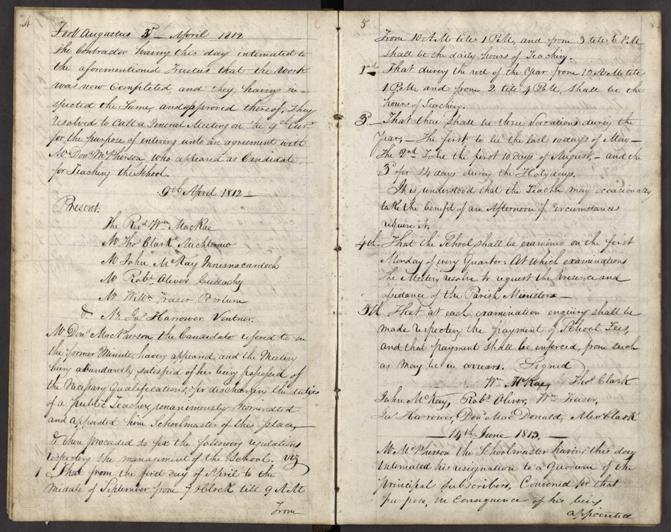
Fort Augustus school minutes from 1812, setting out the opening of the parish school.
National Records of Scotland, CH2/1433/4 page 5
These pages from Fort Augustus kirk session minutes, dated April 1812, set out the planning of a school, giving insight into the school day (starting at 10am until 1pm and from 3pm and finishing at 6pm). However, the schoolmaster, Donald McPherson resigned from the post of schoolmaster the following June and the subsequent pages deal with the business of appointing another ‘superior’ teacher.
Census or population records
In addition to communion rolls and registers of baptisms, marriages and burials, kirk sessions often produced other lists of parishioners, such as male heads of household, rolls of adherents or parish population surveys. In many cases, parish population surveys were a by-product of the gathering of population and vital statistics for official publication, but some parishes appear to have compiled lists of families or persons in the parish for other purposes. They often include individuals’ names, places of residence, occupations, number of dependants and other details but, as with many types of record kept by kirk sessions, the content varies considerably from parish to parish.
Not every kirk session produced or preserved these lists. Moreover, given that apart from the list of heads of households, these records were not statutory, the format and amount of detail they contain vary between parishes.

Detail of a list of questions to be put to the inhabitants of Urquhart parish, Elgin, by the schoolmaster. The completed form is shown, below.
NRS, CH2/1431/21 page B
Here is an example of a form of census to be undertaken by the schoolmaster of the parish. The questions are printed and set out clearly the purpose: to survey the population of the parishioners, noting their age, gender and occupations. Although the names of the parishioners are not listed, this informal survey gives insight into the working lives of the area and its industries.

The census table completed by James Cooper, Schoolmaster of Urquhart parish, Elgin.
NRS, CH2/1431/21 page D
Other census type records are less formal, with lists of names of heads of household or full families arranged by village. This example from the Birse kirk session records is a list of inhabitants from ‘six towns’ and covers the years from 1812 to 1825.

A list of inhabitants for Birse parish, Aberdeenshire, 1812. We have both sexes listed and the local midwife is noted as ‘Betty Bain’ (bottom, left page).
NRS, CH2/595/12 page 11
It is possible to search for similar population records within other parishes by using the search terms ‘census’, ‘inhabitants’ or ‘population’ in the Virtual Volumes keyword search.
Seat rents
Until the second half of the twentieth century, parishioners could rent their pews in the church, which guaranteed them a particular seat. Seat rent books usually record the renter’s name, the sum paid and the position of the seat, thus indicating the person’s standing in the community. Since renting a pew was a privilege, these records do not provide a full list of parishioners, nor do they always include women.
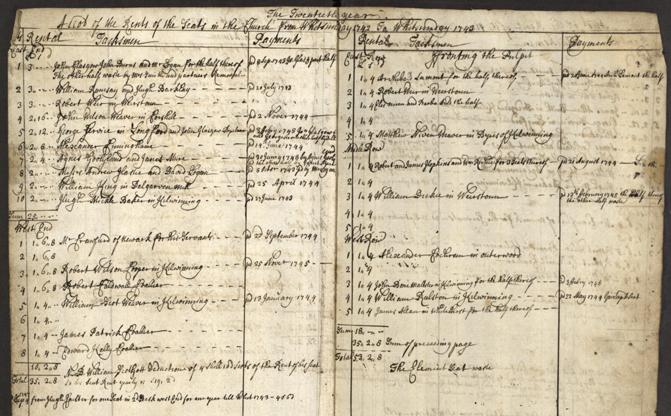
Seat rents for Kilwinning parishioners, with names of both sexes paying rents, occasionally giving the payer’s occupation. Here we see Mr Crawfurd of Newark paying for the seat rent for his servants in 1744.
National Records of Scotland, CH2/591/15 page 39
Some congregations did not keep separate seat rent books. In these cases, lists of seat renters might be included in the minute or account books of the kirk session or, in the case of secession churches, in the minutes or accounts of the managers.
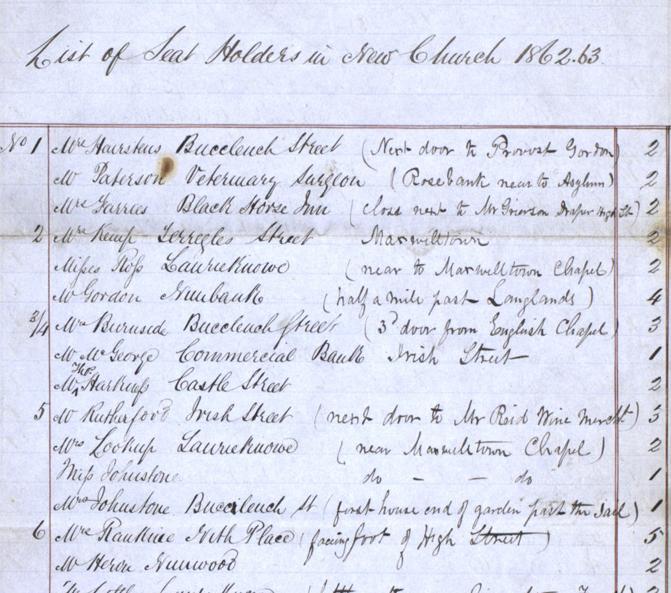
Detail from the list of seat rents for Greyfriars in Dumfries has detailed descriptions of the payer’s addresses and occupations.
NRS, CH2/979/9 page 1
The seat rentals for Greyfriars church in Dumfries create a vivid picture of the town. Mrs Johnstone lived on Buccleuch Street ‘first house end of garden past the Jail’ (page 1), Miss Reid lived on the High Street ‘beside the Fish Depot Castle St.’(page 3). There is also insight into family relationships and living arrangements; Mrs Anderson ‘lives with her aunt Miss Glover’ (page 7).
Communion rolls
Communion rolls vary in the amount of detail they supply, but the most detailed give the communicant's place of residence, occupation, date of admission to the congregation and where he/she had come from. The general remarks column can provide further useful information.

These pages from the St Andrew's kirk session at Alloa list the ‘Communicants’ Roll’ for 1888 - 1896. Details of parishioner’s addresses, and occurrences of those who have left the parish, are given.
NRS, CH2/630/11 page 27
This Communicants’ roll from St Andrew’s kirk, Alloa, gives the reader insight into the movement of the parish. Alexander Archibald has been crossed off the list as he has left to join the ‘Police Force Edinburgh’ and another has become an ‘Officer in Salvation Army’. The marriage of some of the listed individuals is also noted on these pages.
Presbytery separate registers
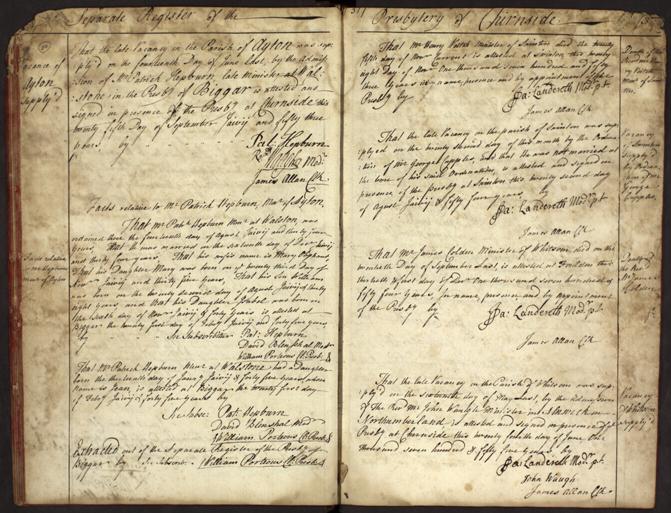
Page from Chirnside presbytery separate register, 1757
NRS, CH2/516/18 page 31
From the 1740s onwards, the Church of Scotland established general funds to support the widows of ministers. In 1757, the General Assembly passed an act requiring the separate registers to be organised by parish, making it easy to trace the career and family details of a particular minister. The register records the appointment of ministers of the Church of Scotland; their marriages and their deaths; the deaths of their wives or widows; and the births, marriages and deaths of their children. A minister’s marriage and births of their children which took place before the minister’s appointment are included as necessary information for the Ministers’ Widows’ Fund. These records are of particular interest if you are tracing the career of a minister and his family history.

These pages from Chirnside separate register set out the templates to be used to record the necessary information.
NRS, CH2/516/18 page 3
This example from the same volume represents the vital life events of Dr Thomas Logan, from his inception as minister at Chirnside in 1801 (replacing the deceased minister, Walter Anderson), his marriage to Agnes Watt, the birth of their children and the death of his wife over the course of two pages.
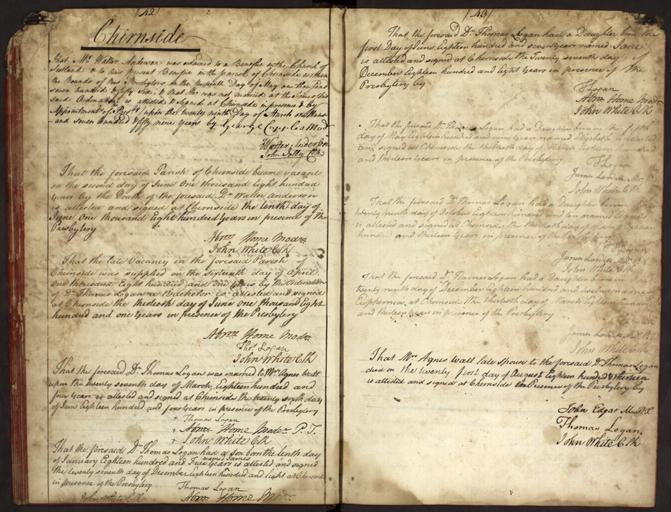
The life and times of Chirnside minister, Thomas Logan.
NRS, CH2/516/18 pages 42 and 43
By using the Virtual Volumes ‘keyword search’, exploring these different record types is effortless; it can narrow your search results but also allows you to search for a wider variety of record types. Another top tip is to search the corresponding records for the parish where you know a family lived. You might be surprised by what you find!
Further reading
You may find the following Scotland's People feature articles of interest:
Our records: kirk session and the poor
Irregular marriage and the kirk session in Scotland
Love lost and found in the Kinnoull kirk session minutes
Tales of witchcraft and witch hunting in Kirkcaldy kirk session minutes
For more information about these records, please see the guidance on church court records and kirk session records and using Virtual Volumes on Scotland's People.
If you are new to reading and interpreting kirk session records, you can find help in our guide to reading older handwriting, the Scottish Handwriting resource and a glossary of abbreviations, words and phrases.